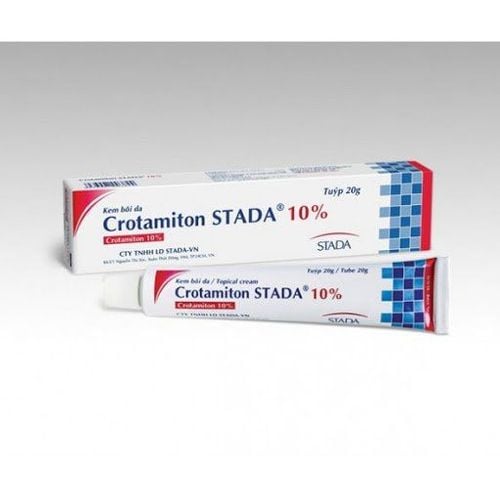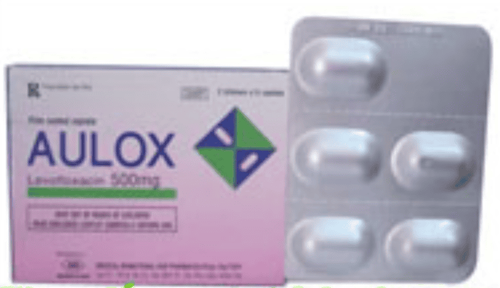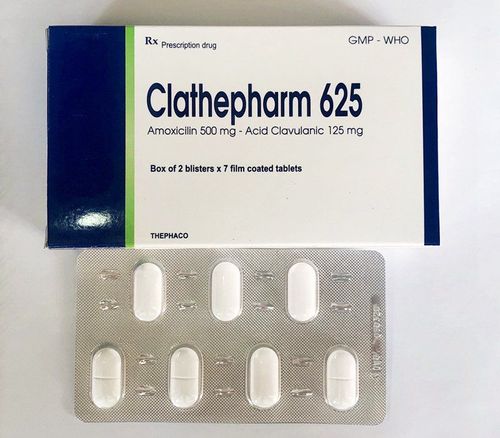This is an automatically translated article.
Glitacin belongs to the group of antiparasitic, anti-infective, anti-viral, anti-fungal drugs and is made in the form of tablets. The main ingredient of Glitacin is Levofloxacin, which is indicated in the treatment of mild, moderate and severe infections. However, Glitacin can cause some side effects such as nausea and vomiting, diarrhea, taste changes,...1. Mechanism of action of the drug Glitacin
The main ingredient of Glitacin is Levofloxacin which is a synthetic antibacterial flourquinolone used as an agent to inhibit bacterial DNA synthesis by acting on the DNA gyrase and topoisomerase V complex. Levofloxacin compounds have other high bactericidal properties in vitro and the spectrum of action of this compound includes both gram-positive and gram-negative bacteria with types such as staphylococcus, streptococci, bacteriophage, pneumococci, intestinal bacteria , haemophilus influenzae, non-fermentative gram-negative bacteria and may include atypical bacteria.When using Glitacin, there is usually no cross-resistance between Levofloxacin and other antibiotics. Infectious diseases caused by Pseudomonas aeruginosa require combination therapy to be effective.
Glitacin is absorbed into the body after taking it quite quickly and has an absolute bioavailability rate of 100%. Food has little effect on the absorption of Aleucin and Levofloxacin compounds.
When entering the body, Glitacin is distributed about 30 to 40% of Levofloxacin compounds bound to serum proteins. With steady state concentrations achieved within 3 days of drug administration. Moreover, Glitacin drug also has the ability to penetrate well into bone tissue, blister fluid, lung tissue. But it's poor at doing this with cerebrospinal fluid.
Levofloxacin component when entering the body is very low metabolism, and metabolites account for less than 5% of the amount excreted in the urine.
Elimination of Glitacin can be done from plasma but is relatively time consuming. Excretion is mainly carried out by the kidneys. But when the kidneys are impaired, the elimination and elimination of this compound by the kidneys will be reduced along with an increased half-life.
2. Indications and contraindications of Glitacin
Glitacin is indicated for the treatment of mild, moderate and severe infections in adults over 18 years of age. With infections related diseases such as acute sinusitis, acute exacerbation of chronic bronchitis, pneumonia, community-acquired pneumonia, skin and skin structure infections, urinary tract infections uncomplicated, acute renal pelvis. However, Glitacin is also contraindicated in cases of hypersensitivity to the drug's components. In addition, it is also contraindicated in patients with epilepsy, patients with a history of tendon pain and related to the use of fluoroquinolone compounds, children or adolescents, pregnant women and women. breastfeeding women.3. Dosage and how to use Glitacin
Dosage for adults in treatment will depend on each disease:For acute sinusitis, it is recommended to use Glitacin at a dose of 500mg / day and use it for 10 to 14 days. Treatment of exacerbations of chronic bronchitis should use Glitacin at a dose of 250 to 500 mg / day and used for 7 to 10 days. Treatment of community-acquired pneumonia with Glitacin 500mg and used from 1 to 2 times a day with a duration of 7 to 14 days. Treatment of complicated urinary tract infections including nephritis - pyelonephritis using Glitacin with a dose of 250mg/day and the duration of use from 7 to 10 days. Treatment of skin and soft tissue infections using Glitacin at a dose of 500mg and 1 to 2 times a day for a duration of 7 to 14 days. dose used with the drug Glitacin. But for patients with impaired liver function and the elderly, there is no need to adjust the dose of Glitacin. Glitacin is taken by swallowing the tablet whole. Patients should not crush it, as it can reduce the potency of the drug. Glitacin can be taken with a meal or between two meals.
Note: The recommended dose of Glitacin is for reference only. Therefore, before using Glitacin, patients should follow the doctor's instructions.
4. Side effects when using Glitacin
Glitacin may cause some unwanted side effects during treatment. However, for each case, the side effects of Glitacin can vary from mild to severe. Some common side effects caused by Glitacin include: Nausea and vomiting, loss of appetite, vomiting, abdominal pain, rash, itching, headache, ringing in the ears, dizziness, drowsiness, insomnia, etc. .. These side effects may occur at the beginning of treatment or after increasing the dose of Glitacin. Usually, side effects from Glitacin can be transient or subside over time.However, in some cases Glitacin can cause serious unwanted side effects with rare reactions. These reactions may appear after just a few minutes of using Glitacin or longer within a few days. When the occurrence of serious side effects such as: bloody diarrhea, pseudomembranous colitis, hypoglycemia, urticaria, bronchospasm, Quincke's edema, hypotension, anaphylaxis, Steven Johnson syndrome , toxic adrenal necrosis, hallucinations, renal dysfunction, asthenia, disturbances in vision, hearing, taste, smell, arthralgia, muscle tendon disorders, tendon rupture, increased liver enzymes, hepatitis, acute renal failure, eosinophilia, leukopenia, neutropenia, etc., the patient should stop using Glitacin and go to a medical facility for immediate medical assistance.
Some notes during the use of Glitacin include:
For pregnant and lactating women, caution should be exercised when using Glitacin, if possible, this drug should be avoided. Patients should be advised to use Glitacin from their doctor, and carefully analyze the benefits and risks before using the drug. Glitacin may change how it works and increase its side effects. Therefore, in order to avoid Glitacin drug interactions, patients should provide their doctor with a list of previously used drugs, including prescription and non-prescription drugs, herbs, ... When using Glitacin, it should be noted. manifestations of an allergic reaction to the drug. Patients should report their reactions to their doctor so that they can be treated promptly. Glitacin can make patients feel dizzy, headache. Therefore, people who operate machinery or drive vehicles should pay attention when using the drug to ensure safety. Above is all information about Glitacin drug, patients need to carefully read the instructions for use, consult a doctor / pharmacist before using. Note, Glitacin is a prescription drug, so patients absolutely cannot buy and treat it at home because they may experience unwanted side effects.













